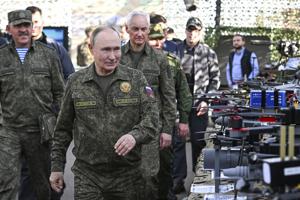Intrusions into NATO airspace attributed to Russia have surged to unprecedented levels this month, raising significant concerns among member states. These incursions may signal an attempt by the Kremlin to gauge the alliance’s resolve and readiness to react to potential military threats, particularly in light of the ongoing conflict in Ukraine. The heightened activity includes a notable incident involving a drone swarm in Poland and violations of airspace in Estonia, Latvia, and Romania.
On September 10, 2023, approximately 20 Russian drones entered Polish airspace, prompting NATO to scramble jets to intercept them. This marked a critical moment, as it represented the first direct military engagement between NATO and Russia since the onset of the full-scale invasion of Ukraine. Although Russia denied targeting Poland, the implications of such actions have been interpreted by European leaders as deliberate provocations aimed at testing NATO’s unity and response capabilities.
Recent Airspace Violations Raise Alarm
Additionally, Estonia reported that Russian fighter jets briefly entered its airspace, an event that the Estonian Foreign Minister, Margus Tsahkna, condemned as “unprecedently brazen.” Meanwhile, Latvia and Romania also reported incursions involving Russian drones this month. These incidents have led to speculation regarding Moscow’s intentions, particularly as it continues to make slow progress on the battlefield in Ukraine.
Prior to its invasion of Ukraine, Russia had demanded that NATO halt its expansion and withdraw military forces from Eastern Europe, including the Baltic states. NATO rejected these demands, leading to heightened tensions. Russian President Vladimir Putin subsequently warned NATO against allowing Ukraine to utilize Western-supplied long-range weapons, suggesting that such actions could provoke a military response from Russia targeting NATO countries.
Experts believe that the recent uptick in airspace violations may be a strategic maneuver by Russia to assess NATO’s reactions and exploit any potential divisions among member states. Hanno Pevkur, Estonia’s Defense Minister, suggested that Russia might be attempting to divert NATO resources away from Ukraine by forcing countries to bolster their air defenses in response to these incursions.
Analyzing Russia’s Strategic Motives
Mark Galeotti, a prominent analyst of Russian politics, characterized these incursions as part of a broader “coercive signaling” strategy designed to dissuade NATO members from providing substantial military support to Ukraine. Galeotti noted that Russia seeks to project an image of being more daring and resolute, emphasizing that its actions are intended to raise the stakes for NATO.
Edward Lucas, a senior fellow at the Center for European Policy Analysis, posited that Russia’s strategy may also involve sowing doubt among NATO allies regarding their commitment to mutual defense, particularly concerning the Baltic states. Lucas argued that Russia does not need to defeat NATO militarily; instead, it could achieve its goals by undermining the alliance’s cohesion and resolve.
In gauging NATO’s response, some analysts suggest that Russia is particularly interested in the United States’ stance. Max Bergmann, head of the Europe, Russia, and Eurasia program at the Center for Strategic and International Studies, remarked on the perceived lack of urgency in the U.S. response, which could embolden Russian aggression.
In light of these developments, NATO has activated a mechanism allowing member states to convene in response to threats to territorial integrity. Following the drone incident in Poland, the alliance initiated operations to enhance air defenses along its eastern flank. NATO Secretary-General Jens Stoltenberg indicated that the alliance would employ all necessary measures to safeguard against further incursions.
Poland has taken a firm stance, with Prime Minister Donald Tusk declaring that the country would not hesitate to shoot down any object entering its airspace. However, there remains uncertainty regarding whether all NATO members would support such an aggressive approach, as decisions on engagement would depend on intelligence assessments of the threat posed by intruding aircraft.
While U.S. President Donald Trump initially suggested that the drone incident could have been accidental, he later affirmed that NATO should respond decisively to any further incursions. Nonetheless, he refrained from confirming whether the U.S. would directly support NATO operations in such scenarios.
As tensions continue to escalate, the implications of these airspace violations are far-reaching. The evolving dynamics between NATO and Russia underscore the complexities of international security and the delicate balance of power in the region. The situation remains fluid, with potential ramifications for both the ongoing conflict in Ukraine and the broader security landscape in Europe.
